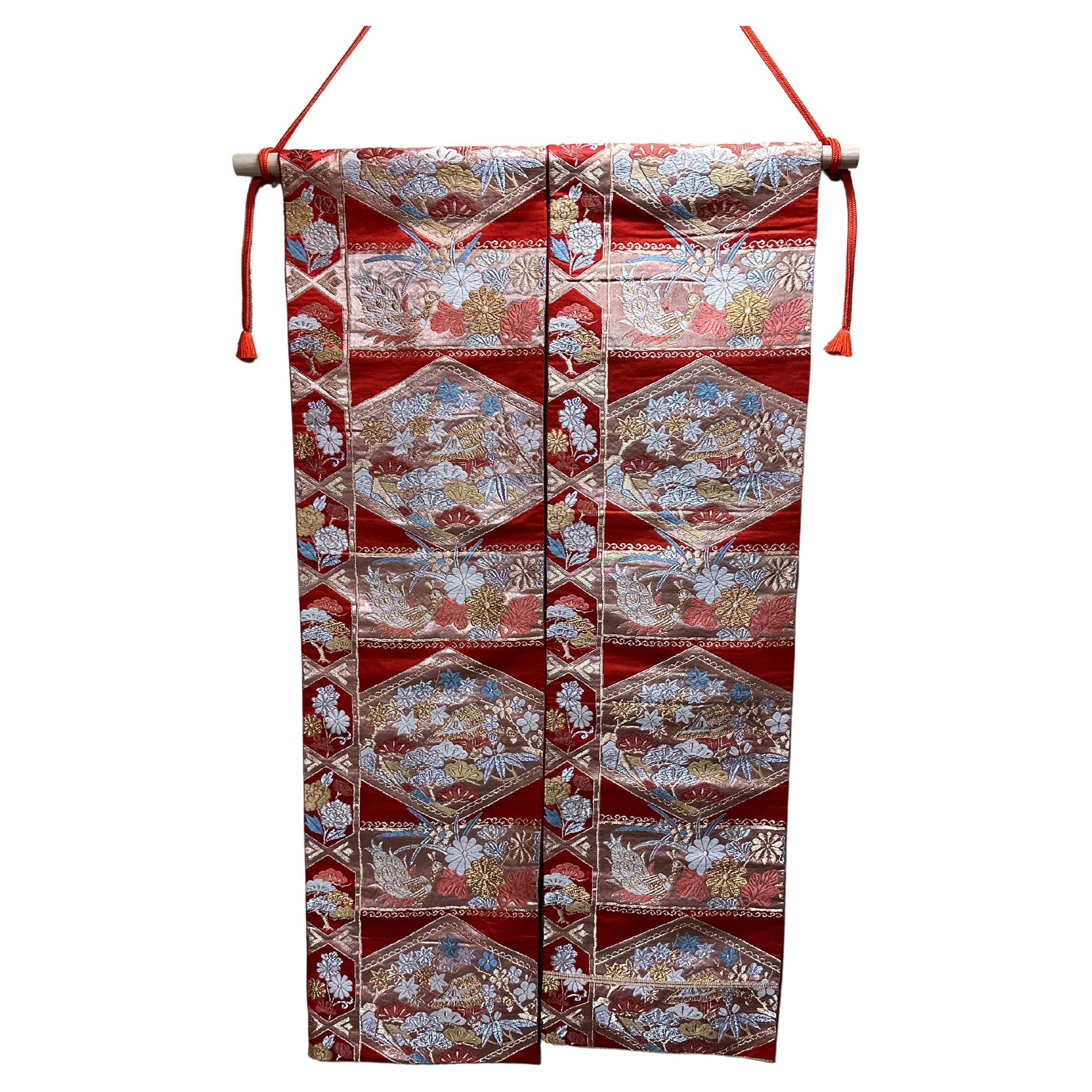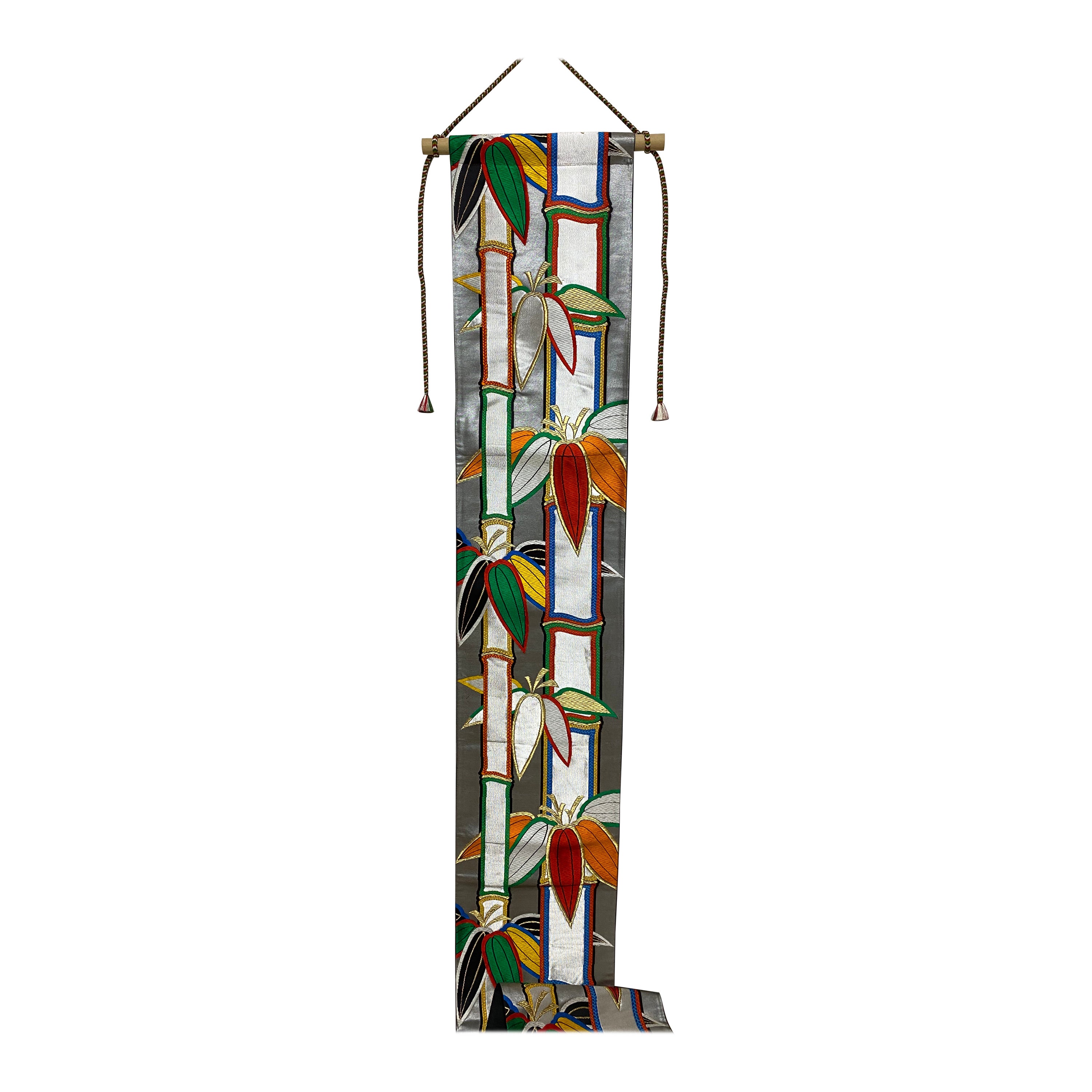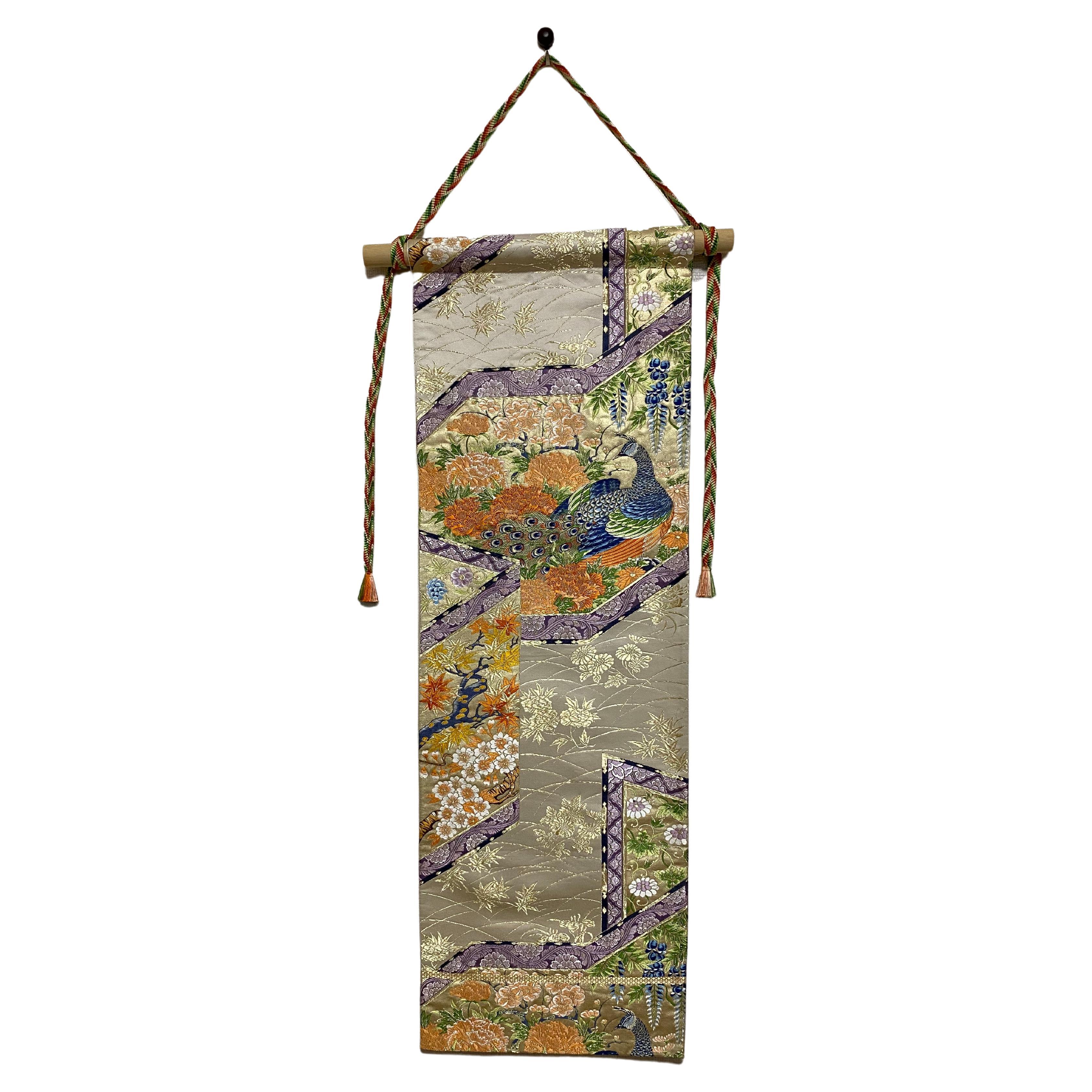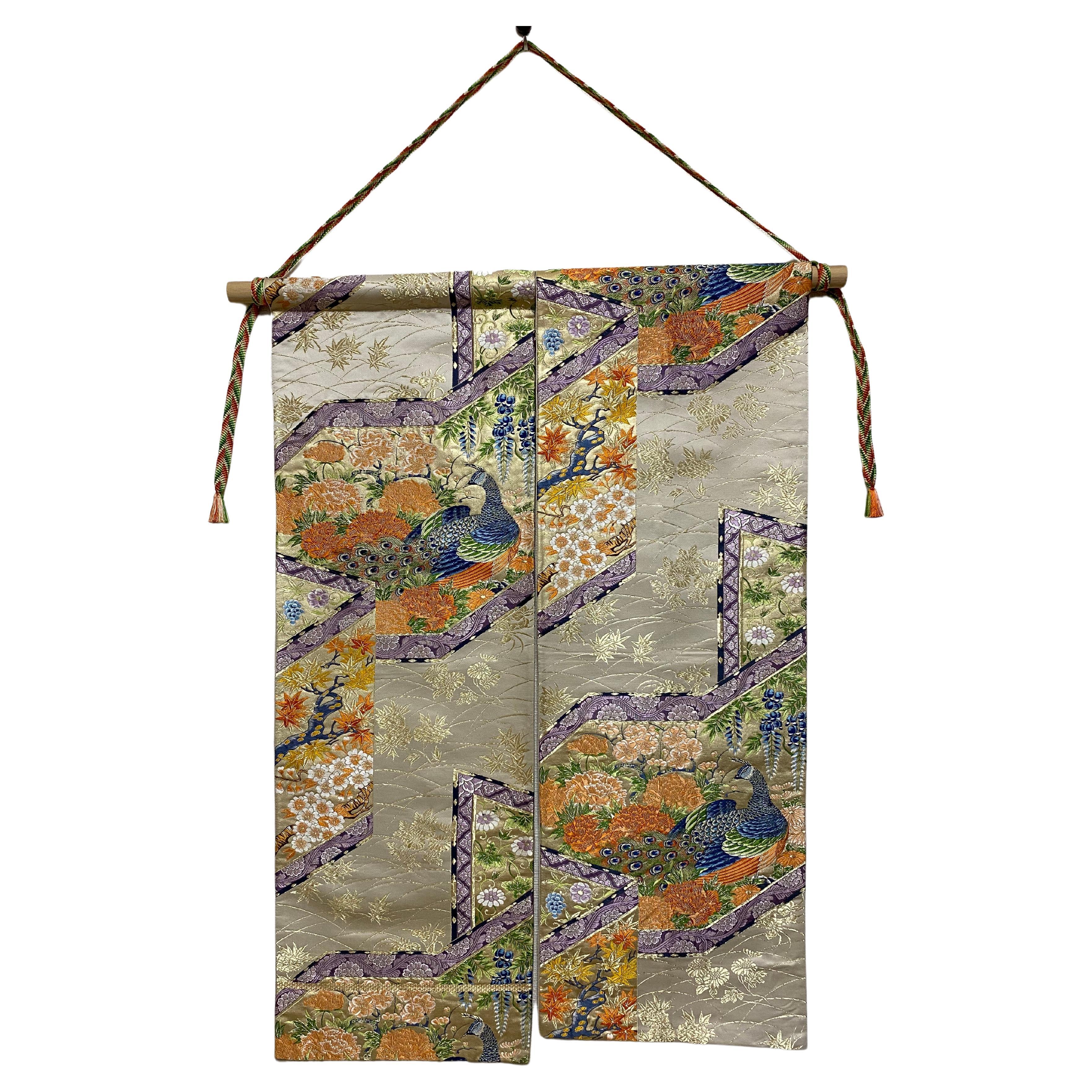Items Similar to Japanese Kimono Art / Kimono Tapestry, Large Flower(KC34-AB)
Video Loading
Want more images or videos?
Request additional images or videos from the seller
1 of 8
Japanese Kimono Art / Kimono Tapestry, Large Flower(KC34-AB)
About the Item
This kimono art is truly one-of-a-kind, seamlessly blending timeless Japanese beauty with sophisticated modern interior design. It expresses the exquisite artistry found in the traditional kimono obi and brings an enchanting allure to any contemporary space.
Renowned for their delicate design and opulent beauty, kimono obis are synonymous with elegance. Kimono obis with vibrant embroidery in orange, pink, purple, and green on a striking black background exude enchanting allure and unparalleled depth. By bringing the original patterns and colors of the obi to life, they bring a wealth of color to a room and create a truly enchanting atmosphere.
A fusion of traditional Japanese kimono culture and cutting-edge contemporary art. It has a special appeal for both lovers of Japanese tradition and those seeking a truly unique design. Immerse yourself in the captivating fusion of traditional Japanese aesthetics and modern style, and elevate your space with unparalleled charm.
- Dimensions:Height: 48.82 in (124 cm)Width: 27.56 in (70 cm)Depth: 0.4 in (1 cm)
- Materials and Techniques:
- Period:
- Date of Manufacture:2022
- Production Type:New & Custom(One of a Kind)
- Estimated Production Time:Available Now
- Condition:
- Seller Location:Shibuya City, JP
- Reference Number:1stDibs: LU8102234484612
Kimono-Couture
Japanese Kimono Art by Kimono-Couture Kimono-Couture proudly creates one-of-a-kind Kimono Art using the highest quality Japanese-made obi. Japanese obi are meticulously crafted through countless intricate processes. We firmly believe that obi represent the culmination of Japan's world-renowned craftsmanship. However, as the culture of wearing kimonos has declined, opportunities to appreciate their beauty have significantly diminished. Therefore, at Kimono-Couture, it is our mission to share the splendor of Japan's traditions, culture, and sensibilities and contribute to the world of kimono culture through the creation of Kimono Art. At Kimono-Couture, our skilled artisans painstakingly examine every detail of each obi to bring out its maximum charm, including patterns, colors, and dimensions. Kimono Art conveys various wishes and meanings through its patterns and colors. For instance, the peacock pattern symbolizes "compassion," "abundance," and "health," while the crane pattern represents "vitality" and "longevity." Detailed explanations of the themes and beliefs behind each piece are available in the description section of our works, which we invite you to explore. We take immense pride in delivering our Kimono Art and your satisfaction is our utmost priority. We offer the option of customizing from your preferred patterns and colors, and we are also happy to suggest recommendations based on the wishes and meanings of Kimono Art. Please don't hesitate to contact us!
About the Seller
5.0
Vetted Seller
These experienced sellers undergo a comprehensive evaluation by our team of in-house experts.
Established in 2022
1stDibs seller since 2023
9 sales on 1stDibs
- ShippingRetrieving quote...Ships From: Tokyo, Japan
- Return PolicyA return for this item may be initiated within 7 days of delivery.
More From This SellerView All
- Japanese Kimono Art / Tapestry, LongevityLocated in Shibuya City, TokyoThis orange silk-based obi is decorated with a tortoiseshell l pattern. The tortoiseshell pattern was handed down from China during the Asuka period in Japan. During the Heian period , only aristocrats were allowed to use the pattern, and the general public could not even see it. Therefore, the tortoiseshell pattern is known as a sacred and prestigious pattern. The tortoiseshell pattern is a regular hexagonal pattern, derived from the shell of a turtle. The regular hexagon is said to be the most stable shape in nature, which means ""sturdy and strong. Today, it is also said to be a pattern that brings good luck in money. The tortoiseshell pattern is decorated with pine trees, bamboo, plum blossoms, and flowers of the four seasons such as chrysanthemums, daffodils, autumn leaves, and peonies. In Japan, the pine, bamboo, and plum trees have been a traditional Japanese good-luck charm since around the Edo period Pine trees are as long as 200 to 400 years old, and some are thousands of years old. Pine trees grow in harsh environments where other trees cannot thrive, and they are considered a symbol of vitality and longevity because of their year-round blue foliage. Bamboo is a symbol of prosperity of offspring because it grows straight and straight with new shoots. Because of its nutritional value, the plum tree played the role of a medicine against illness in ancient Japan. When a Japanese emperor fell ill, he ate...Category
21st Century and Contemporary Japanese Tapestries
MaterialsSilk, Thread
- Japanese Tapestry / Kimono Art -Rainbow Bamboo-Located in Shibuya City, TokyoThis one-of-a-kind work of art, using a traditional kimono obi, is a masterpiece of Japanese craftsmanship. On a black silk ground and silver foil base, a gorgeous bamboo is embroidered by gold and silver threads and colorful silks such as red, yellow, orange, and green. Bamboo is a symbol of "healthy growth" and "steadfast loyalty" as it grows straight, strong, and spreads lush green leaves even in the cold of winter. As described in "Taketori-Monogatari" (the oldest story in Japan), it has been believed since ancient times that spiritual power resides in the joints and knots of bamboo. Thus, bamboo has been long cherished as a mysterious good-luck charm. This work evokes both the formidable power of bamboo and the elegance that overflows from the delicate use of color. In addition, although it is a traditional Japanese kimono obi...Category
21st Century and Contemporary Japanese Tapestries
MaterialsSilk, Thread
- "Seasonal Blessings" by Kimono-Couture, Japanese Art / Kimono TapestryLocated in Shibuya City, TokyoKimono Tapestry "Seasonal Blessings" by Kimono-Couture ・Japanese Kimono Tapestry ・Textile Art ・Japanese Hanging Scroll 【Description of Kimono Art b...Category
21st Century and Contemporary Japanese Tapestries
MaterialsFabric, Yarn, Thread, Silk, Tapestry, Textile
- Japanese Kimono Art / Kimono Tapestry, The Queen of PeacocksLocated in Shibuya City, TokyoKimono Tapestry by Kimono-Couture Prepare to be enthralled by our exquisite kimono tapestry, meticulously crafted from a traditional kimono obi by skilled Japanese artisans. This one-of-a-kind tapestry embodies the essence of timeless artistry. The foundation of this kimono obi is crafted from silk, embellished with delicate strokes of gold leaf, creating a mesmerizing backdrop for the arabesque pattern. The arabesque, inspired by the ivy's vigorous growth in all directions, symbolizes vitality. In the Edo period (1600-1868), it was revered as a representation of longevity and prosperity, adding a touch of auspiciousness to this magnificent tapestry. Adorning the obi is an enchanting embroidered peacock, celebrated for its resplendent feathers. The peacock embodies qualities such as compassion, fertility, and good health. Its indomitable life force, evident in its ability to consume poisonous snakes and insects, grants it the power to ward off evil spirits and protect against misfortune and suffering. Surrounding the peacock, a tapestry of flowers...Category
21st Century and Contemporary Japanese Tapestries
MaterialsGold Leaf
- Japanese Kimono Art / Kimono Tapestry, the King of PeacocksLocated in Shibuya City, TokyoThis Japanese kimono tapestry is the only one of its kind in the world. It has been carefully and meticulously embroidered by Japanese craftsmen. We are proud to present this Kimono tapestry, embroidered with peacocks and flowers of the four seasons on a silk fabric based on the traditional color called “Kinari.” The peacock symbolizes “compassion,” “fertility” and “good health.” Because its life force is so strong that it eats poisonous snakes and insects, the peacock is believed to ward off evil spirits and prevent against “misfortune” and “suffering.” Japan is famous for its drastically different seasons. As the colorful flowers bloom, we can sense that the seasons are changing. Each of the flowers on this piece are carefully chosen. Plum blossoms, wisteria, and cherry blossoms in the spring; iris and hollyhock blossoms in the summer; chrysanthemum blossoms and grapes in autumn; and peony blossoms in the winter. This is a wonderful Japanese tapestry...Category
21st Century and Contemporary Japanese Tapestries
MaterialsSilk
- Japanese Art / Kimono Art / Tapestry, the King of PeacocksLocated in Shibuya City, TokyoThis Kimono Tapestry, carefully and painstakingly embroidered by Japanese craftsmen, is the only one of its kind in the world. We are proud to present this tapestry, embroidered wi...Category
21st Century and Contemporary Japanese Tapestries
MaterialsSilk, Thread
You May Also Like
- Old Japanese Kimono / 1912-1945 / Wall Hanging Decoration / TapestryLocated in Sammu-shi, ChibaI think this is a kimono woven from the Taisho era to the early Showa era (1912-1945) in Japan. It is a modern design. In the Taisho era, various things were made with reference to...Category
Early 20th Century Japanese Taisho Tapestries
MaterialsCotton
- Japanese Asian Large Meiji Period Silk Embroidery Peacock Bird Flower TapestryLocated in Studio City, CAA stunning Meiji Period (1868-1912) Japanese large framed embroidery/ tapestry featuring a pair of finely detailed birds - likely peacocks in a floral garden landscape. A truly magn...Category
Antique 19th Century Japanese Meiji Tapestries
MaterialsSilk, Glass, Wood
- Large Japanese Embroidery Tapestry Meiji PeriodLocated in Atlanta, GAA large and finely embroidered Japanese tapestry with brocade border, circa 1900s Meiji period. The tapestry depicts, in a rather realistic style, a forested landscape in autumn flan...Category
Early 20th Century Japanese Japonisme Textiles
MaterialsBrocade, Silk
- Large Framed Japanese Embroidery Dragon TapestryLocated in Atlanta, GAAn impressive Japanese embroidery tapestry circa 1890s Meiji period, presented with brocade border on linen canvas in a Lucite shadow box. The stunning design features three dragons coiling and flying in the clouds. The high relief technique used to render the dragons using mostly the silver threads gives this piece a tremendous sense of motion. The most auspicious mythological creature in Japan and China, dragons were a very popular motif in textile art. In this particular piece, it is the impressive size, the superb craftsmanship, the profuse use of silver threads and near perfect condition that set it apart. Japanese Meiji textiles were widely exhibited in the west during turn of the 20th century at the international exposition. It was used to showcase the Japanese aesthetics with the techniques at their pinnacle. These expositions solidified the country's images overseas and felled the Japanese craze in the west, which turned out to be a long-lasting influence on the western art. Many pieces were purchased and stayed in the west. It is likely this estate piece was from one of the expositions based on its high quality. For two similar dragon tapestries...Category
Antique 1890s Japanese Japonisme Textiles
MaterialsTextile, Lucite
- Exceptional Embroidered Japanese Ceremonial KimonoLocated in Atlanta, GAA visually striking antique Uchikake Wedding Kimono/Robe for ceremonial occasion, circa end of Meiji to Taisho period 1910s-1930s. This bridal outer garment is of a bright red color ...Category
20th Century Japanese Japonisme Textiles
MaterialsBrocade, Silk
- Antique Japanese Embroidery TapestryLocated in Atlanta, GAA large Japanese silk embroidery tapestry circa 19th century, late Edo to early Meiji period. Meticulously handwork that densely depicts repea...Category
Antique 19th Century Japanese Japonisme Textiles
MaterialsSilk
Recently Viewed
View AllMore Ways To Browse
Jean Picart Le Doux On Sale
Korhogo Mud Cloth
La Dame A La Licorne
Le Guen
M Ray Tapestry
Patrice Allard
Psychedelic Nude Tapestry
R Debieve
Rare Vintage Egyptian Tapestry
Reeves Tapestry
Rene Fumeron On Sale
Robert Debieve On Sale
Ted Morris
Vintage Vestimenta
Bird Needlepoint Art
Hindu Tapestry
Large Japanese Embroidery Tapestry Meiji Period
Marc Petit






